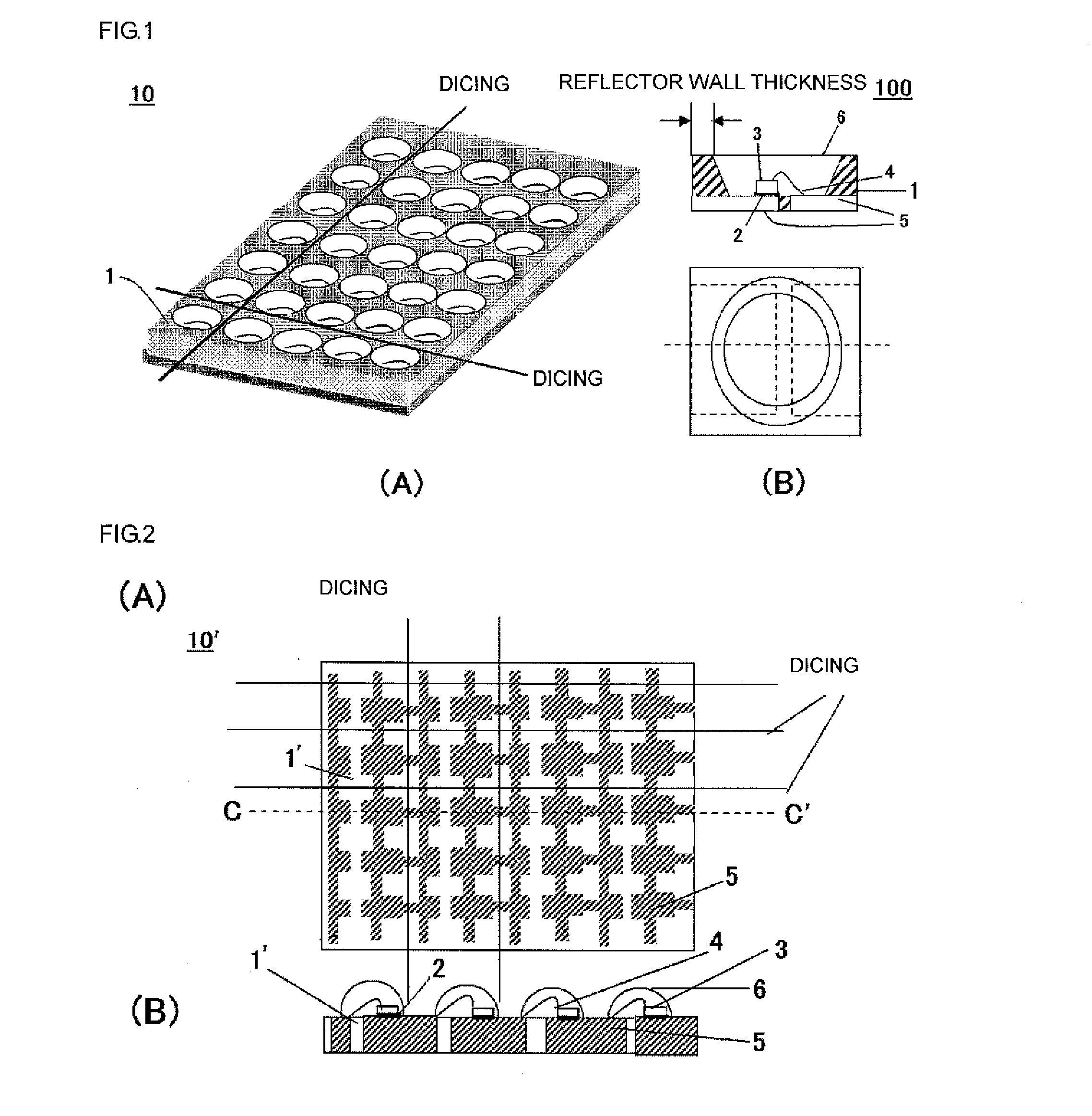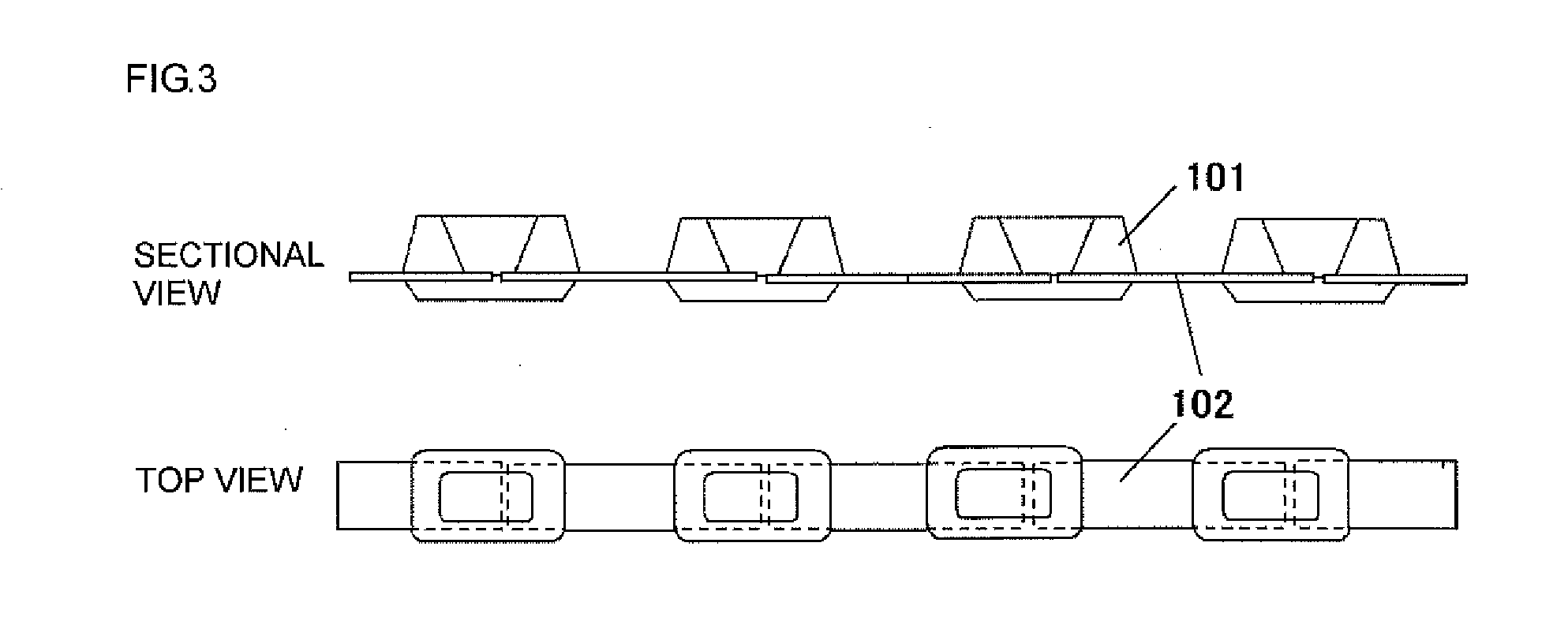Thermosetting silicone resin composition for reflector of LED, reflector for LED using the same and optical semiconductor apparatus
a technology of silicone resin and reflective material, which is applied in the direction of silicon compounds, solid balls, silicates, etc., can solve the problems of resin color change, resin deterioration, and the demand for reliability and durability of leds becoming more severe, so as to achieve excellent heat resistance and light resistance, less light leakage to the outside, and less warpage of the board
- Summary
- Abstract
- Description
- Claims
- Application Information
AI Technical Summary
Benefits of technology
Problems solved by technology
Method used
Image
Examples
synthesis example 1
Synthesis of Organopolysiloxane (A-1)
[0119]In a flask were charged 1000 g of xylene and 5014 g of water, and a mixture comprising 2285 g (10.8 mol) of phenyltrichlorosilane, 326 g (2.70 mol) of vinyldimethylchlorosilane and 1478 g of xylene was added dropwise thereto. After completion of the dropwise addition, the mixture was stirred for 3 hours, waste acid was separated and the resulting mixture was washed with water. After azeotropic dehydration, 6 g (0.15 mol) of KOH was added to the mixture, and the resulting mixture was refluxed at 150° C. overnight. The mixture was neutralized with 27 g (0.25 mol) of trimethylchlorosilane and 24.5 g (0.25 mol) of potassium acetate, and after filtration, the solvent was distilled away under reduced pressure to synthesize Organopolysiloxane (A-1) which was transparent and solid state at room temperature. The vinyl equivalent was 0.0013 mol / g, and the hydroxyl group content was 0.01% by mass. The softening point was 65° C.
synthesis examples 2 to 4
Syntheses of Organopolysiloxanes (A-2) to (A-4)
[0120]Hydrolysis was carried out under the same blending and conditions as in Synthesis Example 1, after azeotropic dehydration, KOH with an amount shown in Table 1 was added, and heating reflux and neutralization treatment were carried out to obtain Organopolysiloxanes (A-2, A-3 and A-4). The results are shown in Table 1.
TABLE 1Synthesis Example1234Organopoly-(A-1)(A-2)(A-3)(A-4)siloxaneKOH amount6 g3 g0.76 g0.51 g(0.15 mol)(0.075 mol)(0.0135 mol)(0.0091 mol)Softening point65605856(° C.)OH group amount0.010.050.10.2(% by mass)
synthesis example 5
Synthesis of organopolysiloxane (A-5)
[0121]In a flask were charged 1000 g of xylene and 5014 g of water, and a mixture comprising 2285 g (10.8 mol) of phenyltrichlorosilane, 300 g (2.3 mol) of dimethyldichlorosilane, 100 g (0.72 mol) of methylvinyldichlorosilane, 326 g (2.70 mol) of vinyldimethylchlorosilane and 1478 g of xylene was added dropwise thereto. After completion of the dropwise addition, the mixture was stirred for 3 hours, waste acid was separated and the resulting mixture was washed with water. After azeotropic dehydration, 0.5 g (0.0125 mol) of KOH was added to the mixture, and the resulting mixture was refluxed at 150° C. overnight. The mixture was neutralized with 27 g (0.25 mol) of trimethylchlorosilane and 24.5 g (0.25 mol) of potassium acetate, and after filtration, the solvent was distilled away under reduced pressure to synthesize Organopolysiloxane (A-5) which was transparent and had high viscosity at room temperature. The vinyl equivalent was 0.0018 mol / g.
[012...
PUM
| Property | Measurement | Unit |
|---|---|---|
| Percent by mass | aaaaa | aaaaa |
| Percent by mass | aaaaa | aaaaa |
| Percent by mass | aaaaa | aaaaa |
Abstract
Description
Claims
Application Information
 Login to View More
Login to View More - R&D
- Intellectual Property
- Life Sciences
- Materials
- Tech Scout
- Unparalleled Data Quality
- Higher Quality Content
- 60% Fewer Hallucinations
Browse by: Latest US Patents, China's latest patents, Technical Efficacy Thesaurus, Application Domain, Technology Topic, Popular Technical Reports.
© 2025 PatSnap. All rights reserved.Legal|Privacy policy|Modern Slavery Act Transparency Statement|Sitemap|About US| Contact US: help@patsnap.com



